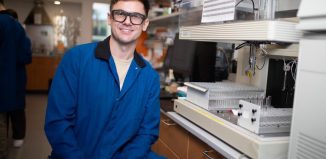SBU’s Gordon Taylor studies Caribbean microbiology
Decreased sardine yield and rising water temperatures are part of global warming trend
As if the southern Caribbean weren’t already hot enough, the water temperature has climbed in the last 14 years at the same time that trade winds have weakened. While this may sound encouraging to scuba divers, it’s not such good news for plankton, the sardines that feed on them and the Venezuelan fishermen who depend on these small fish for their livelihood.
Above the Cariaco Basin, an ocean trench a few miles offshore from Venezuela, a local decline in trade winds has limited the movement of nutrient rich waters, contributing to a reduction in plankton production and, in part, to a collapse in local sardine fisheries, according to research by Gordon Taylor, a professor of microbiology at Stony Brook’s School of Marine and Atmospheric Sciences.
Working in collaboration with Mary Scranton, a Stony Brook professor, as well as researchers at several other U.S. and Venezuelan institutions, Taylor has traveled from Stony Brook to Venezuela every six months, monitoring oxygen, carbon, sulfur, nitrogen and other metals in the water, as well as the abundance and growth of microorganisms from the surface to the sea floor.
The decline in sardines, as measured by some of Taylor’s colleagues, has been dramatic. Sardine fishery landings were 40,000 tons in the last year, down dramatically from 200,000 tons in 2004. Overfishing also contributed to the steep drop.
Slower trade winds are a problem for the region because they interfere with a process called nutrient upwelling. The deeper, cooler regions of the ocean have more nutrients because that’s where plants and animals decompose. As this living matter sinks, it releases “the Miracle-Gro of the ocean,” Taylor explained.
The chemicals involved in water cycling through the ocean include nitrogen, phosphorous, silica and trace metals — some similar components people put on their lawns or potted plants.
The nutrients in the colder water typically cycle towards the surface. In upwelling, friction from winds pushes surface water away from the coast. That brings deeper, nutrient-rich water to the surface to replace it. With the change in the winds, the nutrients don’t reach the basin.
At the same time, the temperature of the water has increased by about 1.1 Celsius degree. While Taylor acknowledged that “1 degree doesn’t sound like a lot,” he urged people to “keep in mind that 1 degree represents a tremendous amount of heat being stored in the ocean.”
Global warming is causing both the higher water temperatures and the change in the trade winds, Gordon asserted.
“All indications from the International Panel on Climate Change is that the heat budget for the planet is on a one-way track at the moment because of fossil fuel combustion,” he said. “We continue to add more carbon dioxide to the atmosphere much faster than it’s being consumed.”
The Stony Brook professor said he has been aware of climate change for four decades, but his research has helped him understand the pace of that change.
“I was aware of the Greenhouse Effect back in my college days in the 1970s,” he indicated. “However, I remained skeptical about how fast it may be occurring, its dangers and didn’t appreciate the many ramifications of climate change until about 15 to 20 years ago.”
His studies, however, suggested “how fast the effects can be detected in the Tropics.” He cautioned that once the planet crosses a tipping point, the ecosystem can enter a “new state in a very short amount in time.”
Taylor lives in East Setauket with his wife, Janice, and their Rhodesian ridgeback dog, which is all of 113 pounds and is still not fully grown.
Their daughter Olivia just completed a program in fine arts. She lives in Manhattan, where she paints and sculpts, and works in a clothing boutique in SoHo.
Taylor has also studied the western part of the Long Island Sound, where he has examined the physical, chemical and biological causes of low oxygen levels, or hypoxia.
Taylor enjoys traveling to Venezuela, where he can continue to gather information, visit with colleagues, and study an area that he’s gotten to know well over the more than a decade since he started collecting water samples.
He has a “terrific set of friends” that he started this project with and, because he’s been doing this for so long, they’re all “growing old together.”
The microbes that are the subject of his work and his teaching at Stony Brook “are underappreciated,” he suggests. “We all owe our existence to them.”
Correction:
In the Power of Tree column that ran last week (Nov. 22), the caption for Esther Takeuchi incorrectly indicated her location. She was in her lab at Stony Brook University. She has a joint appointment from SBU and Brookhaven National Laboratory. The photo was provided by SBU. We regret the errors.






